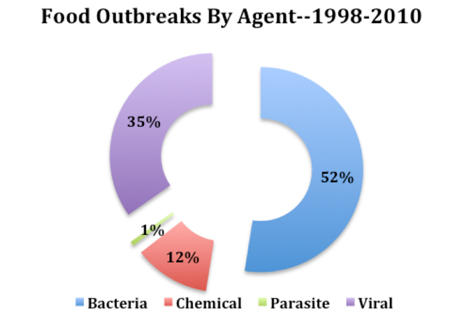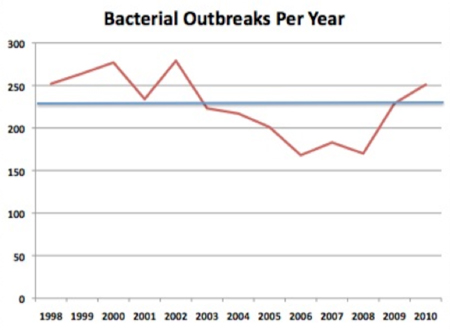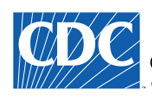In Strategic Consulting’s last blog, I questioned whether the safety of the US food supply is as bad as reported. My point was that the numbers—of actual outbreaks and illnesses—don’t match the level of public fear or media hype.
Some new reports from the CDC—published online last week ahead of print—have me wondering if the CDC is partially to blame for the over-reporting and hype. Because the levels and frequency of food outbreaks in the new reports are quite low when compared to the annual estimates broadly provided by the CDC.
It seems our food supply is safer than portrayed, even by the CDC, which is tasked with monitoring food safety.
To see how the numbers led me to this conclusion, let’s start with the broad numbers reported on the CDC webpage, “Estimates of Foodborne Illness in the United States” (www.cdc.gov/foodborneburden/index.html):
1. 1998—76 million illnesses; 325,000 hospitalizations; 5,000 deaths
2. 2009—87 million illnesses; 371,000 hospitalizations; 5,700 deaths
3. 2011—48 million illnesses; 128,000 hospitalizations; 3,000 deaths
These numbers certainly paint a bleak picture of food safety in the US. It’s also worth noting, however, that the most recent CDC estimates (for 2011) indicate significant improvement in conditions over the past 3-4 years.
The two CDC reports/data sets are rich in information regarding food outbreaks in the 13-year period from 1998-2010, including outbreak causes by year, by agent (bacterial, chemical, parasitic and viral) and by food type.
• Attribution of Foodborne Illnesses, Hospitalizations, and Deaths to Food Commodities by using Outbreak Data, United States, 1998–2008 (wwwnc.cdc.gov/eid/article/19/3/11-1866_article.htm)
• Surveillance for Foodborne Disease Outbreaks — United States, 2009–2010 (www.cdc.gov/mmwr/preview/mmwrhtml/mm6203a1.htm)
In some cases the CDC has been able to identify/confirm the causative agent and the food source for outbreaks, while in other cases the cause remains suspected or unidentified. Below are the total numbers for food outbreaks combined for this 13-year period (confirmed, suspected, and unidentified):
 The outbreak and illness numbers in these two CDC reports are much smaller than indicated by the broad CDC metrics, even when taking into account suspected and unidentified outbreaks. How does CDC support the current reporting of an estimated 48 million illnesses in the US, when their own numbers, on average, show only 1,145 total outbreaks per year resulting in 23,186 illnesses, and 470 confirmed outbreaks causing 11,520 illnesses?
The outbreak and illness numbers in these two CDC reports are much smaller than indicated by the broad CDC metrics, even when taking into account suspected and unidentified outbreaks. How does CDC support the current reporting of an estimated 48 million illnesses in the US, when their own numbers, on average, show only 1,145 total outbreaks per year resulting in 23,186 illnesses, and 470 confirmed outbreaks causing 11,520 illnesses?
A Closer Look at CDC Foodborne Outbreak Numbers
Strategic Consulting has taken a closer look at the data in the CDC reports, and highlights some of the information of interest to food producers and QA managers. For this analysis, only CDC’s confirmed outbreak numbers were used because the data included the causative agent and food type.
As the table below indicates, bacteria are the leading causative agent for foodborne disease outbreaks, responsible for 52% of confirmed events over the 13-year period. Viruses were the second leading cause at 35%. The breakdown of illnesses by agent follows a similar pattern.

 To determine if there were any critical trends by year, SCI analyzed the food outbreaks caused by bacteria on a year-by-year basis. It is worth noting in the chart below that bacteria-based food recalls had generally declined over the period, but then spiked again in 2009 and 2010.
To determine if there were any critical trends by year, SCI analyzed the food outbreaks caused by bacteria on a year-by-year basis. It is worth noting in the chart below that bacteria-based food recalls had generally declined over the period, but then spiked again in 2009 and 2010.
Illnesses caused by food outbreaks from bacteria have been reasonably steady year to year over the past 13 years.
Given the importance of bacteria as a causative agent, SCI conducted additional analysis of the CDC data on bacterial outbreaks. Visit www.strategic-consult.com/blog/ to learn more.
Food Safety—Better Than Reported
So, where does all this leave us? I’ll reiterate the point made in my previous blog that any food outbreak is undesirable, and can be tragic. However, it is also clear that the numbers of outbreaks and illnesses presented in this 13-year analysis are much smaller than the CDC’s broad numbers indicate.
I think that 470 identified outbreaks per year that each, on average, impact 25 people is an accomplishment for the food industry. Certainly there is room for additional improvement but this performance seems much better than is often portrayed.
Another data point to consider in comparison: In the US, 314 million people eat 2-3 meals a day, 365 days per year—about 300 billion meals per year. Given these numbers, 99.996% of these meals do not result in a confirmed illness. I think those are pretty good odds.
Tom Weschler is president and founder of Strategic Consulting, Inc. www.strategic-consult.com. Over his 30-year career in international management in the industrial marketplace, Mr. Weschler has created, implemented, and redirected numerous businesses, with demonstrable successes in venture capital backed start-ups, publicly traded companies, transformation of underachieving companies, and technology acquisitions. He can be reached at 802.457.9933 or weschler@strategic-consult.com.



